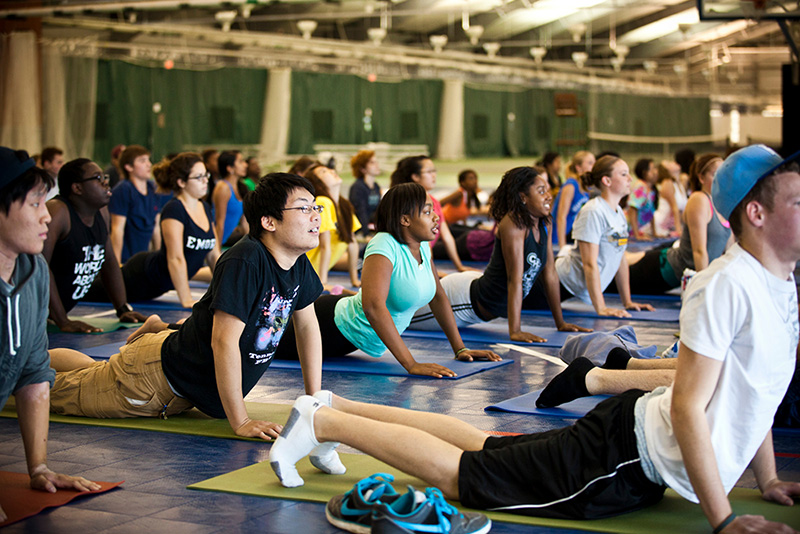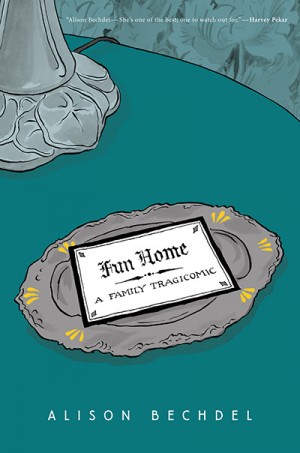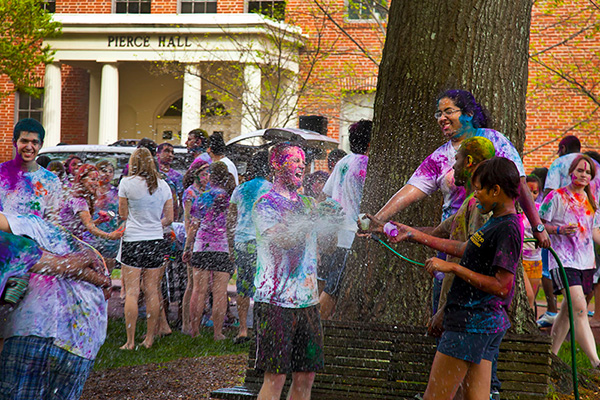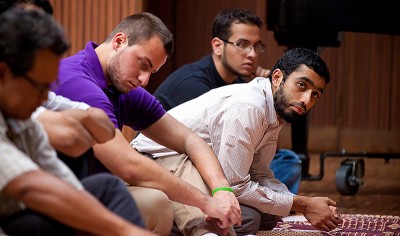
Briallen Hopper
It’s back-to-school season. Pumpkin lattes are here, school supplies are on sale, and thousands of students are showing up at college and trying to figure out what religion means in their lives.
For some students, figuring out faith in college will be a relatively straightforward process that might involve taking a cool-looking religion class, joining a religious student group, or blithely deciding to prioritize sleep over worship services.
For others, things will be more complicated. They may feel self-conscious about praying in front of a roommate. They may unexpectedly stray from their atheist or Orthodox roots, and feel unsure about how to tell their parents. Or they may come to the conclusion that their religious beliefs are in conflict with their academic work.
For Duke freshman Brian Grasso, things got complicated quickly. First, he determined that his religious beliefs prevented him from reading Alison Bechdel’s award-winning graphic novel Fun Home: A Family Tragicomic, which was Duke’s optional summer assignment for incoming freshmen. Then he shared his decision not to read it on Facebook. Before long he found himself at the center of a national controversy, and wrote an op-ed explaining himself in the Washington Post.
Grasso’s story prompted a lot of knee-jerk culture-wars responses. His decision was caricatured by The Stranger as “Incoming Duke Freshmen Refuse to Read Alison Bechdel’s Fun Home Because Lesbians Are Gross” and applauded by Breitbart as “Duke Students Say No to Lesbian Porn.” (This, despite the fact that according to Grasso the book’s gay and lesbian themes were not a factor in his decision not to read it.) More nuanced takes include Aaron Bady’s analysis in The New Inquiry, which argues that the national media magnified Grasso’s private Facebook post and the supportive comments it received into a non-existent mass student boycott, which in turn resulted in a deluge of vague or unfounded diatribes against students.

As a liberal Christian academic who used to be a conservative Christian student, and as an Alison Bechdel fan who absolutely loves Fun Home, I found a lot to sympathize with both in Grasso’s dilemma and in the many criticisms of his decision. I remember what it’s like to be an earnest teenager with tightly-held religious beliefs that sometimes set me apart from my peers. (I still have tightly-held religious beliefs that sometimes set me apart from my peers!) At the same time, I couldn’t help nodding along with the chorus of commenters who said things like, “Kids these days need to understand that college is supposed to be about engaging with diverse people and beliefs and being open to learning new things!”
But would Brian Grasso actually disagree with that definition of college? After reading his op-ed, I was primarily struck by how much Grasso and his critics have in common. Grasso has been both condemned and celebrated for challenging the liberal secular consensus about what a college education should be about—diversity, tolerance, open-mindedness. But according to his own op-ed, he actually shares these values.
Right off the bat, before he cites Jesus or the Bible, Grasso tells us he has nothing against reading books by LGBTQ people or by “Freud, Marx, and Darwin.” He sees engaging with different perspectives as a necessary part of his college education, and he’s perfectly happy to read secular and anti-Christian texts. It’s sexually explicit images that he has a problem with, and that goes for Renaissance art as well as lesbian coming-of-age stories. And Grasso doesn’t even say professors shouldn’t assign sexually explicit images; he just says they should warn students about them in advance.
Most striking of all, Grasso concludes his op-ed not with a conversation-stopping appeal to Scripture or God, but with consensus-building appeals to “cultural pluralism” and “genuine diversity.” He approvingly cites a Muslim student who sent him a message of support, and tells us about a woman who “considers herself bisexual and Buddhist” who started a Facebook conversation with him about their differing beliefs, which resulted in “deeper compassion and understanding for each other.” Grasso’s final lines are a tribute to his mutually respectful, mutually beneficial dialogue with the bisexual Buddhist: “That is what college is really about.”
The “Duke freshmen” scandal has a lot to tell us about religion on campus. It’s simultaneously predictable and disheartening, surprising and encouraging. It’s also unsettling in ways that are harder to express.
Most obviously, the scandal reminds us how combustible and reductive discussions of religion can be. The polarized and over-simplified accounts that went viral (Duke students are closed-minded homophobes! Duke students are being forced to read lesbian porn!) tapped into visceral fears and frustrations that continue to derail many conversations about religion. In this way, the story can be seen as yet more evidence for the persistence of the worst of the American culture wars well into the 21st century.
But it’s also a sign that by some measures, on secular campuses at least, the culture wars are over and the pluralists have won. After all, Grasso is not claiming that Duke is violating his religious freedom, or demanding that Bechdel’s book be banned. Nor is he attempting to start a crusade to take back Duke for God. He is simply choosing not to look at pictures of people having sex, and he is appealing to shared secular values to defend his ability to make this choice. These days, even a conservative Christian student’s decision not to read a sexually explicit book by a lesbian can be publicly framed by the student’s stated support of diversity, his avowed willingness to “grapple with” Marx and Darwin, and his appreciation for the perspectives of Muslims, Buddhists, and queer people.
After the media uproar, Grasso’s op-ed felt careful, conciliatory, even anti-climactic. It was also a strong testament to the miraculous power and capaciousness of a pluralistic campus culture. Within this value system, even a nationally-debated, sexualized, highly-charged clash between belief systems can be reframed as an opportunity for dialogue, learning, and growth.

And this is mostly good news. After all, a shared commitment to mutually appreciative diversity is our best bet for making campus religion into something that feels good and runs smoothly. It’s what allows a Jewish student descended from Holocaust survivors who spent the happiest years of his life studying at a yeshiva in Israel to sit at a seminar table with a Palestinian-American student whose grandparents were forced to abandon their ancestral Jerusalem home, and together with the assorted Catholics and agnostics and Buddhists and worshippers of Beyoncé, they can participate in discussion, tell jokes and stories, and open themselves to mutual education.
At its best, to fall into the language of my own faith, these diverse and pluralistic academic values can create classroom conversations that seem like a Holy Communion, a Peaceable Kingdom, a Beloved Community. And sometimes, it really does seem to me that “this is what college is really about.”
But, as I’m increasingly aware, these experiences of academic utopia are not the whole story. Because outside the classroom, as we all know, religion (like race, like nationality, like oil) is still something that people kill and die and go to jail for. It is not the cause of all wars, but it is one of the causes of some of them. It is anti-vaxxers, celebrities, celibates, suicides, refugees, politicians, Duggars, Kim Davis: not just as social texts or objects of discussion, but as lives lived and lives lost. It is the polarized, inaccurately reported stories that play out on social media, in all their lurid splendor. And, more immediately for our students, it’s something to love and hate and live by and struggle with. It is so many things that a calm conversation based on mutual respect can’t account for, or even allow.
As an academic who teaches a potentially fraught freshman seminar on “Religion in America,” I cultivate a classroom community of pluralism, diversity, and mutuality. I encourage my religious students to learn about the best aspects of others’ traditions and the worst aspects of their own, and I invite my atheist or agnostic or “nones” students to do the same. I don’t hide my own religious background, but neither do I dwell on it. I invite guest speakers with a multitude of perspectives to talk about their varied areas of expertise. Through our engagement with historical documents, fiction, film, memoir, scholarship, and site visits, my students and I rely on an academic mixture of empathy and detachment to talk productively about some of the most difficult subjects on earth.
At the same time, I know that religion for my students is not just something that can be printed on a line marked “Religious Affiliation, If Any,” or calmly discussed in class or explained in an op-ed. It’s the loyalty they feel to the suffering of their grandparents, the shame they feel about their porn binges or drunken hookups, the comfort they feel at a shared weekly meal that they can’t find anywhere else. It’s what compels them to spend time with people that they otherwise have nothing in common with. It’s their impulsive whispered prayers before they take a test. It’s the unease they feel when Jesus is mentioned. It’s the pride and defensiveness they feel about the haircut or headcovering or bracelet that they constantly have to explain. It’s the propulsive force inside them that prompts them to fight fossil fuels, join the army, forgive. It’s the insomnia they experience in the nights leading up to their decision not to do the assignment.
Last fall, one of my students refused to do an assignment because it conflicted with his religious beliefs.
He was one of the most engaged students in the class. I’d let him in off the waitlist for “Religion in America” even though a space never opened up because I couldn’t say no to his enthusiasm. My student—I’ll call him Jake—plunged into the coursework with focused energy, writing excellent essays on Martin Luther King, Jr. and Shalom Auslander, and a brilliant research paper on American Jewish ways of celebrating (or not) Halloween, Thanksgiving, and Christmas. He was a gifted reader and writer, committed to research and revision and open to constructive criticism. In class discussions, he was an exemplary listener who made thoughtful comments and asked great questions.
Then in November it was time for the students to do the final assignment, the site visit. I asked them to visit a religious site, service, or celebration that they wouldn’t otherwise go to, and give a presentation on their experience to the class using the academic texts and analytic frameworks they’d been working with over the course of the semester. It’s hard to imagine a more pro-diversity, pluralism-happy assignment, and every year it generates many feel-good stories like Brian Grasso’s story about his Buddhist friend. Students enjoy getting a chance to learn about the Muslim community off-campus, celebrate Diwali with their friend’s Asian dance troupe, or go to Mass with their roommate. And they are able to contextualize these experiences using the scholarship they’ve read about immigration, race, ritual, or law. Even students who use the assignment to confront ideological difference– like the pro-choice student who scoped out a pro-life church—tend to find the experience interesting and academically valuable.
But for Jake the assignment prompted a lot of anxiety. Though he’d visited historic church buildings as a tourist when he was younger, he was gradually coming to the conclusion that visiting a site or service from another religious tradition would violate his own understanding of Judaism. After class one day he gave me a heads-up that he wasn’t sure whether he could find a way to do the site visit, but he was trying to figure it out. I told him to keep thinking about it and keep me posted. Finally, after a lot of reflection and soul-searching, he wrote to tell me he was just not comfortable with the assignment, and asked if I had ideas about what he might do instead.
I told Jake his task was to give an academically rigorous presentation about why he couldn’t do the assignment, with the goal of making his perspective comprehensible and meaningful to me and his classmates.

Meanwhile, another excellent student, Isaac, had run into a different but related problem. He was a Jewish student who had no problem with attending services of different faiths, and he’d gone to Mass expecting it to be an illuminating cross-cultural experience. At first he settled in comfortably, observing the service with interest and enjoying the familiar psalm. But during the Jesus-focused homily, he began to feel unsettled, outnumbered, even surrounded. He remembered stories his grandfather had told him about Catholics’ prejudice against and persecution of Jews. He remembered his mother’s discomfort with the idea of the idea of a crucifix hanging on the wall in a shared dorm room. Before he went to Mass, he hadn’t viscerally understood their sense of other faiths as an imposition or even a threat. He left feeling troubled and alienated.
After the visit, Isaac asked me: is it appropriate for me to talk about these negative feelings in my presentation? Or would that be considered offensive or academically off-topic? I told him, yes, please talk about them. Describe them, interpret them, help us understand what they mean.
There were many thought-provoking student presentations that semester, but Jake’s and Isaac’s prompted some of the most searching discussions, opening up a space for the class to talk about religion in a way that we hadn’t before. Their presentations pushed against the limits of pluralism in a way the original assignment didn’t, which meant that we all ended the semester with a sense of American religion as something that vastly exceeded the terms of the class. It was the opposite of closure, and over the past year it has been changing the way I think about teaching religion.
Of course, in some ways my students’ trouble with the class and my response to it are simply more demonstrations of the way genuine conflict can be turned into fodder for pluralistic epiphanies. And it’s true: religious resistance and refusal can often be folded into the framework of academic diversity without too much trouble. But I think their experiences and mine are also a meaningful postscript to the happy ending of Brian Grasso’s op-ed, pointing to the academic value of anxiety, impasse, and alienation.
At the end of the semester, Isaac and I ended up having a challenging conversation in which he talked about how the relentlessly respectful and affirming climate of our class sometimes felt like a constraint. There was a moment early on, he told me, when someone had said “everyone knows that 9/11 had nothing to do with Islam,” and he’d felt like I, or campus civility, was quickly smoothing over the possibility of debate, silencing difference before it could be spoken.
How do you allow for difference, account for difference, speak difference, without falling into the combustible clichés or smooth resolutions of the Duke freshmen scandal? Without turning your class into a warzone or a diversity brochure?
I told Isaac that some kinds of conversations are only possible when you have already established a conversation—when you can speak in a shared language with people you trust. And that takes time: maybe a whole semester, maybe a lifetime. I still think that’s true. But I’ve been thinking ever since about how to make more space in my classroom for religion as refusal and discomfort and risk. Because after all, this is what college is about too.
Briallen Hopper is Faculty Fellow at the University Church, a Fellow at Ezra Stiles College, and a Lecturer in English at Yale University. Her research interests are in American and African American literature, political protest, popular culture, religion, education, and film. She can be followed @briallenhopper.
